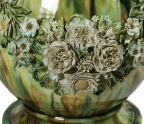From Bizen to Iowa: A modern-day pilgrimage

Three Japanese potters travel 6,000 miles to share the ancient art of Bizenware with the potters of America’s heartland.
Early last summer, Taiga Mori, Syo Fujita and Toshiaki Mori arrived in the rolling hills of Eastern Iowa. They’d come for an artistic and cultural exchange at the invitation of Ben Jensen, Executive Director of the Ceramics Center, Iowa’s largest public access facility for ceramic and warm glass art. The visit would include four days of teaching and five days of firing the wood-fired kiln that sits behind the Center. Since the trio spoke little English, and Ben spoke no Japanese, it promised to be a learning experience for everyone.
1,000 years in the making
Bizenware is known for its distinctive reddish- to blackish-brown color. Although the pieces aren’t glazed, Bizen potters use a variety of techniques to produce rustic surface effects. Named after the village of Imbe, in Okayama prefecture, and formerly known as Bizen province, this style of pottery has passed from hand to hand for 1,000 years.
In the mid-16th century, influential Japanese tea masters began using Bizenware in their tea ceremonies. Utilitarian vessels originally meant for farmers became
You’re reading a preview, subscribe to read more.
Start your free 30 days





